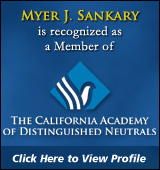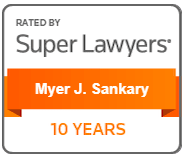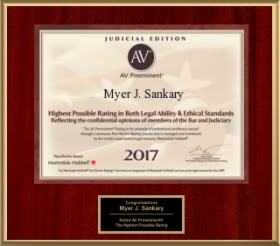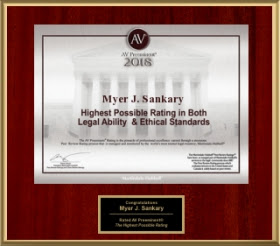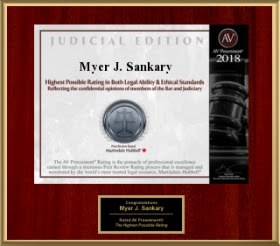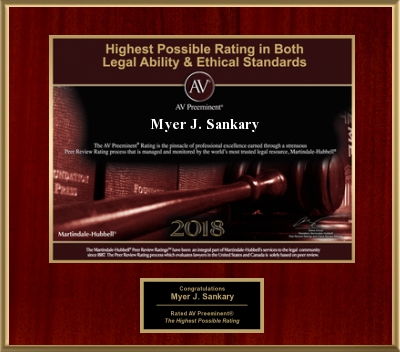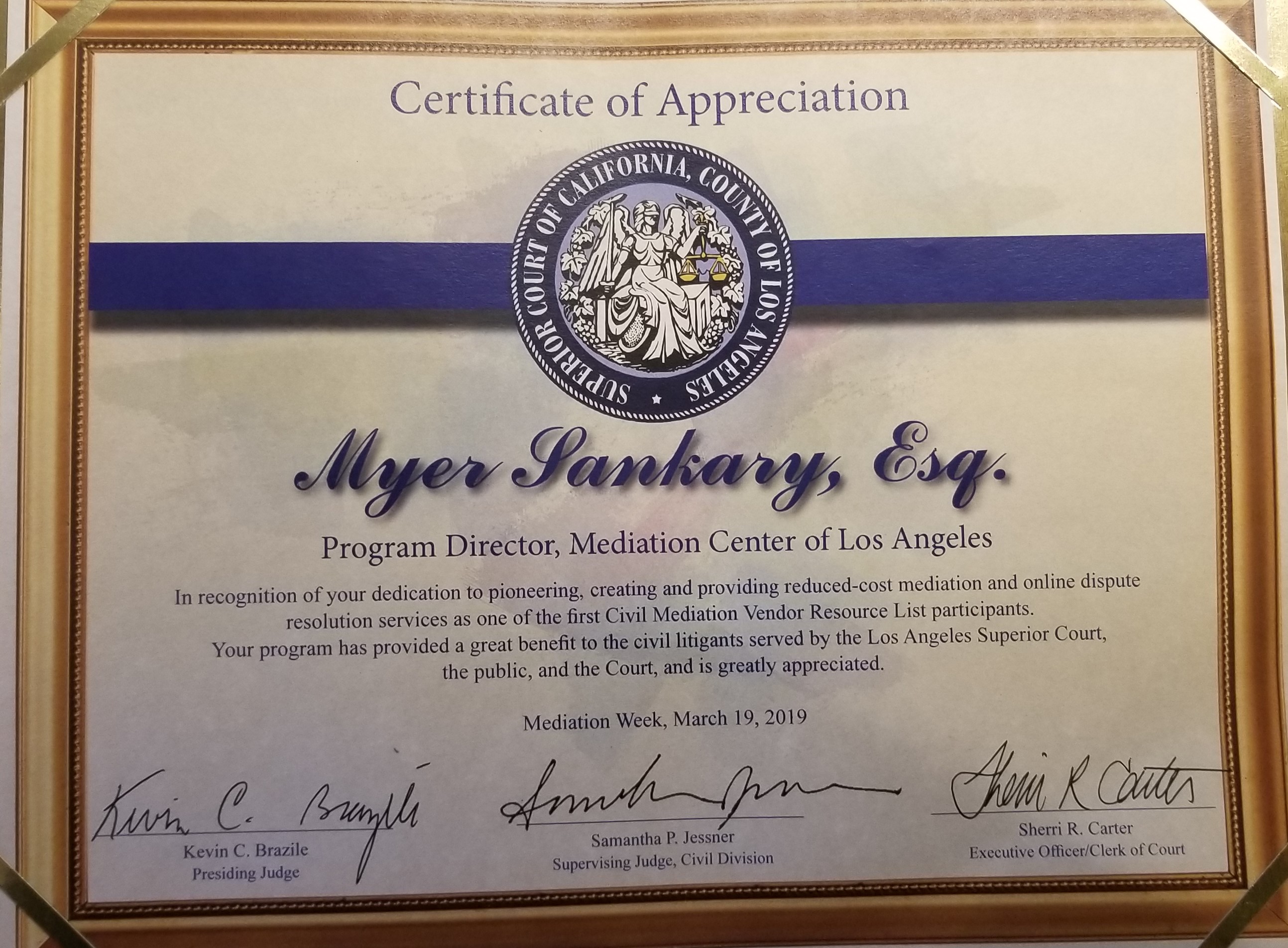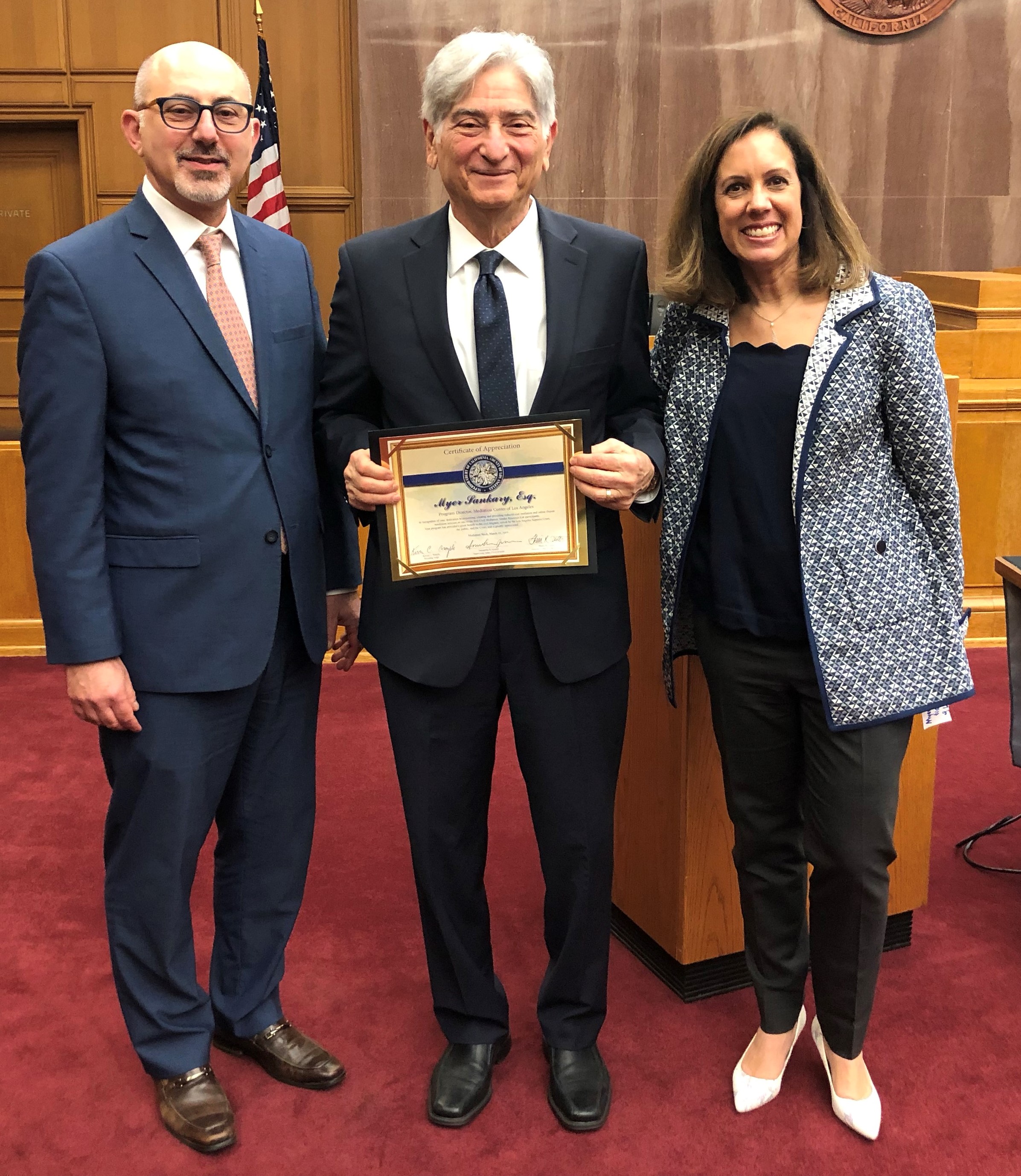
Stage One
Good Decision Making Is Key To Successful Negotiations
by Myer Sankary
The process of making a decision whether to accept a settlement proposal or reject it and go to trial deserves the lawyer’s best efforts, skill, knowledge and judgment. Too often, the decision is made without careful thought, but rather is the result of undue optimism or pessimism, and is clouded with emotional frustration. Lawyers are often unaware of the different stages of negotiating a legal dispute and sometimes press for a resolution before the case is ripe for settlement. This article will review the four stages of a legal dispute with emphasis on the fourth and critical stage – making a decision to reach agreement or accept an impasse.
Failure to develop and consistently implement an objective rational decision making process often leads to acceptance of a settlement that is far less than what a client might have obtained if the attorney had been better prepared for this critical phase of the negotiating process., Moreover, poor decision making can result in an unnecessary trial that is costly for the client as well as the attorney. A disciplined decision making process may not result in the “best possible settlement” (for that goal is not always attainable), but it can lead to a “reasonable decision” which the client and the attorney can make and live with in confidence.
Most lawyers are natural negotiators. They love to argue and persuade others to their point of view. Many rely on intuition and past experience as their primary guide through the negotiation process. Unfortunately, because negotiating efforts come so easily to some lawyers, they fail to analyze what they are doing or to learn how to improve their negotiation skills. . Failure to examine negotiating tactics and strategies can lock us into patterns of thinking and behavior that defeat our primary objectives which is to represent our clients competently in making deals and settling disputes. (Some may disagree and argue that the main objective of the lawyer is to get the maximum amount of money or obtain the best possible result for his or her client.)
Clients seek advice from their lawyers because of their knowledge, experience, analytical skills and good judgment. In representing a client in either a deal or a dispute, lawyers are generally capable of investigating the facts, researching the law and drawing conclusions about whether a client has an actionable claim or whether a deal meets legal muster. Indeed, lawyers usually perform competently during the first three phases of the negotiation process as outlined below, but it is in the critical fourth stage when poor decision making can lead to poor results.
[1]
Orientation, Positioning And Developing Strategy
In this initial stage, attorneys gather facts, evaluate their client’s story, research the applicable law, draw certain preliminary conclusions about the claims or defenses of their client’s case, contact opposing counsel and explore the negotiating environment. The lawyer will begin to develop a strategy or roadmap that will lead to the desired result.
In the opening stages, attorneys may signal to opposing counsel either a cooperative, problem solving approach or an adversarial competitive one. A cooperative lawyer will indicate that he will want to work with his colleague to reach a fair and equitable outcome for both parties based upon fair objective standards. He may also indicate that he follows an integrative approach seeking to create options and to package a deal that meets everyone’s interests and needs. The competitive lawyer may demonstrate a maximalist approach – asking the most he can get for his client, perhaps even asking a lot more than he expects to get, leaving room for some compromise, but always in his client’s favor.
It is essential that the skilled negotiator detect whether he is dealing with the “cooperative” or the “competitive” lawyer early in the negotiations and understand what to expect in order to adjust one’s own approach so as not to become manipulated, bullied or exploited. Studies have indicated that a cooperative approach can be very effective, but not if the opponent is adversarial. A tit for tat approach may be required at least until the cooperative approach is accepted by all participants. Through the early stages, each negotiator will signal the style that he or she will use. A lawyer should be prepared to react appropriately.
Stage Two
Discovery, Perception, Argument, Persuasion
At this stage, the lawyer tries to obtain as much information about both sides of the case as possible either through formal discovery or through direct communications, written and oral. In the course of discovery, the negotiator tries to shape the perception most favorably toward his own case so that his opponent will believe that his client will ultimately prevail in his claim or defense. Through presentation of arguments the issues become more defined, strengths and weakness become apparent, and each party tries to find out the real position of the other. The advocate may tend inflate the merits of his case in hopes that his opponent will overvalue his hand. (An unintended consequence of exaggerating a claim is that the client may come to believe that he or she is entitled to the maximum demand – this can become a serious obstacle to settlement unless the client has been thoroughly advised about the true range of value including the potential for loss if the opposition’s case is believed.) Some concessions may be made at this stage. The style of each negotiator becomes apparent through discovery – either full disclosure is made to reasonable questions or objections and roadblocks prevent exchange of information.
Stage Three
Emergence And Crisis
At this stage, negotiators come under pressure from court deadlines, financial constraints, and ultimate trial dates. Each side realizes that concessions must be made, new options created, or they face impasse and the risk of trial. Crisis is reached when neither side wants to make further concession; both sides are fearful of being exploited or manipulated, no more room for compromise seems possible; breakthrough is required to avoid future expenses and uncertainties; and the client is concerned about whether he should accept his lawyer’s advice to settle. The legal advisor should have prepared the client for the eventual critical crossroads of decision making which will lead the client to the certainty of settlement or the uncertain risk of trial.
Stage Four
Agreement Or Impasse – Making a Decision
The pressures of cost, uncertainty of outcome, and sufficient compromise usually brings the parties to agreement in more than 90 percent of litigated cases. This is the stage that is most critical for the client, because a fundamental decision must be made whether to accept the last proposal, continue to negotiate thereby risking withdrawal of a final offer, or proceed to trial.
It is during this critical final stage that the lawyer must have a disciplined systematic approach to decision making to enable him to give competent professional advice to his client. Unfortunately, in these circumstances, when the client is reliant the most on his lawyer for helpful advice, some lawyers are not equipped with the analytical skills necessary to advise their clients to make a “smart choice” not a “perfect one!”
Making a decision whether to accept or reject a last and final walk-away offer is indeed one of the most important decisions a client will be required to make. Counsel must always remember that the final decision whether to settle or go to trial is the client’s, although that decision is usually based upon counsel’s judgment and advice. Yet, all too often, the client is surprised to find out that the final best offer falls far short of his expectation which was based upon his attorney’s assurances about the value of his case. It is not uncommon for tensions to arise between a client and his attorney resulting in a loss of trust and confidence. A client, who has not been prepared to face the critical crossroad of decision making, may refuse to accept an offer recommended by his own attorney.
Attorneys and their clients are often disappointed in the mediation process because it resembles an arm-twisting mandatory settlement conference. These encounters are highlighted by judicial pressures and threats with nothing more to support the final decision than judicial intimidation. In this context, neither the attorney nor the client feels that a decision to settle was based on a fair and rational process.
On the other hand, through the assistance of an experienced mediator trained in decision making process, the lawyer can receive support in his advice to his client about why the last offer is a reasonable one under the circumstance that should receive serious consideration. The mediator can assist both parties in understanding the decision making process so that they can have confidence that the decision was a good one based upon a rational analysis.
The Lawyer Has a Duty to Obtain a Reasonable Compromise if Possible
The standard for determining whether a lawyer has met his professional obligation by recommending a settlement in litigated cases was recently examined in Barnard vs. Langer. In Barnard, [2] a client claimed that the attorney was negligent by compromising his claim without achieving the “best” possible result. The appellate court rejected this claim, citing Mallen, on Legal Malpractice (fn. 13 – see below):
“The standard should be whether the settlement is within the realm of reasonable conclusions, not whether the client could have received more or paid less. No lawyer has the ability to obtain for each client the best possible compromise but only a reasonable one.” Barnard at p. 588 (emphasis added).
One of the best discussions about how to make a rational decision of an offer to settle a litigated case in the face of uncertainty can be found in the book, Smart Choices. [3]
The Smart Choice approach is based upon eight elements, referred to as PrOACT. Harvard Business School Professor Howard Raiffa explains that a smart decision requires a step-by-step analysis of the core considerations:
Three additional elements — uncertainty, risk tolerance, and linked decisions help clarify more complex decisions, such as whether to take the last proposed offer.
Lawyer should keep in mind several key concepts. In deciding whether to accept an offer, the litigant should isolate three essential considerations:
1. The chances of winning at trial and, if so, the different possible jury awards.
2. The time and stresses associated with trial and not going to trial, together with the degree of the litigant’s regret if she loses, or satisfaction if she wins.
3. The litigant’s willingness to take risk Supra, at p. 127
A decision to accept a final and last offer or to reject it and go to trial is a choice between finality and certainty on the one hand and continued litigation in the face of an uncertain outcome on the other hand. A competent lawyer will develop analytical tools to advise his client about how to make such a decision based upon a consistent rational approach to problem solving.
The lawyer should prepare a risk profile to simplify decisions involving uncertainty as follows:
A. Identify Uncertainties
Many uncertainties exist within a lawsuit, such as what facts will be admitted to support each claim or defense; how will the judge rule as to admission of evidence; what testimony will be elicited from each witness ; how will the jury react to the attorneys, to the parties and to the witnesses? Whose story will the trier of fact most likely believe?
B. Define Outcomes
This is a two stage process. First, determine how many possible outcomes are needed to ascertain the extent of uncertainty; and how each possible outcome can best be defined. Second, in a litigated matter, anticipating a variety of possible outcomes is much more useful than predicting only two – a win or a loss. (See table below)
C. Assign Chances
Although difficult to predict, it is important to place a number on each possible outcome, the total adding up to 1 or 100 percent. This exercise replaces fuzzy concepts (“You have a ‘good’ chance of winning”) with precise thinking based upon the lawyer’s experience, knowledge, and judgment. (See table below.)
It is essential to use more refined probabilistic predictions about the litigation outcome in order to compare possible outcomes with the final offer. [4] This requires the lawyer to examine each material issue, weigh the evidence, and make a realistic prediction about the outcome of each finding leading to a final verdict. In predicting possible outcomes at trial, lawyers should try to predict a range of probable outcomes giving each range a probability factor. An effective negotiator should factor the probability of a loss (meaning – the result predicted by your opponent as adjusted by your evaluation of what a loss may mean in financial and legal consequences to your client) together with the probability of a low recovery, average, and high recovery.
For example, in a personal injury case, with some risk of proving liability (or having a major portion of comparative fault attributed to your client) a reasonable prediction may be the following:

Instead of telling the client, “I think you have a good chance of winning,” or “You should prevail,” or “Your position is very risky,” numerical estimates for various probabilistic outcomes gives a more precise statement of your assessment of the case.
By making a prediction of this type, the client will be in a better position to assess what a win looks like as opposed to a loss with the probability of each alternative occurring.
D. Use a Decision Tree as Graphic Illustration of Risk
Use a “decision tree” to graphically illustrate a risk profile. The authors of Smart Choices recommend this method of displaying the interrelationships among choices and uncertainties to create a blueprint for making a complex decision. (See illustrative decision tree analysis at the end of this article)
Counsel should also seek to understand how the decision styles of your client, yourself, and other parties to the litigation affect the negotiating process. A decision style reflects how much information one needs to make a decision, how much time is required to process the information to reach a conclusion and one’s personality trait when under pressure. To force a client to make a decision before all of the information is obtained and understood could result in rejection of the advice.
Also, often overlooked by attorneys who give advice about accepting or rejecting the last offer is the client’s tolerance for risk. This aspect of decision making is perhaps one of the most important elements of decision analysis, for it is based upon each client’s intangible willingness to take risk. Although the attorney may feel more more confident about the outcome of a trial than the client and may therefore be willing to go to court if the settlement is not what the attorney believes is adequate, it is the client’s personal decision whether the cost of losing outweighs the potential upside of winning. More than likely, your client will be more risk averse than you. Risk tolerance can be quantified by desirability or utility scoring. (See pages 140 et seq. in Smart Choices.).
In discussing your client’s willingness to choose the risk of going to trial, be sure not to fall into the following mental traps:
The opportunity for lawyers to utilize these decision-making tools can be found in the mediation process, provided the mediator is knowledgeable and experienced in this dynamic approach. When an attorney guides his clients through the decision making process in negotiations, he must be able to provide sound advice and suggests ways the client can choose whether or not to accept the last best offer. Fortunately, because of the substantial advances in mediation research and training, a knowledgeable and experienced mediator can assist the attorney and his client to make a rational decision. The mediator has the opportunity to learn critical information from the other side which may be unknown to attorney; he can also provide a more balanced approach to quantifying risk assessments on each of the issues in dispute. The right mediator can be a fair and impartial sounding board as well as a trusted guide through the complicated and difficult maze of making a reasonable decision either to accept the certainty of a settlement or to undertake the risk and unknown consequences of a trial.
Whether or not you agree with the opinions and assessments of the mediator, the opportunity to compare your projections and analysis of the possible outcomes of a trial with those of an objective and experienced neutral facilitator should be worth the investment of time and money.
The important thing is to make a decision you and your client can live with. Armed with the knowledge of the four stages of a legal dispute and how to make a smart choice when facing uncertainty, the attorney and his client will have confidence that when they arrive at the critical crossroads, the decision they make will be a reasonable one under the circumstances. At that point making a decision is better than making none at all. When the final choice has to be made, the knowledgeable attorney should keep in mind the wisdom of Yogi Berra who said, “When you come to a fork in the road, take it!
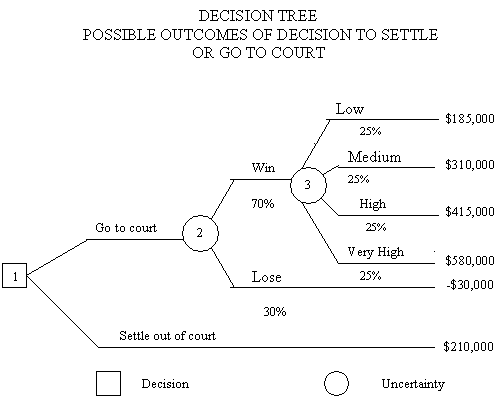
Decision Tree Diagram – Smart Choices, Hammond, Keeney, Raiffa (1999), at 151
Decision Tree Diagram – Smart Choices, Hammond, Keeney, Raiffa (1999), at 151
Illustration of components of making a decision whether to accept an out of court settlement for a net of $210,000 or to go to court with various possible win or lose outcomes.
At Stage 1, the attorney and client must decide whether to accept the settlement or go to court. In making the decision, the attorney should advise the client about possible outcomes based upon the attorney’s knowledge, experience and judgment. In the above example, the attorney believes that there is a 70 percent chance of winning and a 30 percent chance of losing.
At Stages 2 and 3 the outcomes at trial are uncertain, but in making a reasonable decision, the client is better informed when he is told about the range of possible outcomes at trial. This is translated into numbers which the client can understand better than the general observation – “you have a good chance of winning!” Of course no attorney can guarantee a result in litigation, but he should use his expertise and skills to illustrate for his client what a possible win or loss will look like.
Combining the risk profile of trial with the risk tolerance of the client will assist the client in making a reasoned decision, not a perfect one.
[1] One of the classic textbooks on legal negotiations is Legal Negotiation and Settlement, by Gerald Williams (West Publishing 1983). His work is based upon research and studies observing a variety of attorneys negotiate in a number of different settings. One of the important findings of the studies that skilled legal negotiators should know is that every negotiation of a disputed claim goes through four basic stages (page 70 ff)
[2] Barnard vs. Langar footnote 13 D.J. cite: 2003 DJDAR 7090 ( June 23,2003 2d dist –Justice Vogel)
“The hindsight vulnerability of lawyers is particularly acute when the challenge is to the attorney’s competence in settling the underlying case. As a leading legal malpractice text observes, the amount of a compromise is often “an educated guess of the amount that can be recovered at trial and what the opponent was willing to pay or accept. Even skillful and experienced negotiators do not know whether they received the maximum settlement or paid out the minimum acceptable. Thus, the goal of a lawyer is to achieve a ‘reasonable’ settlement, a concept that involves a wide spectrum of considerations and broad discretion. Theoretically, any settlement could be challenged as inadequate, and the resolution is likely to require a trial. . . . A claim regarding an inadequate settlement often fails because it is inherently speculative. Negligence cannot be predicated on speculation that the attorney or another attorney could have secured a more advantageous settlement or the fortuitous event that a jury instead of a judge may have returned a higher award. A client, who was a plaintiff, must establish not only that concluding such a settlement fell outside the standard of care, but also what would have been a reasonable settlement and that such sums would have been agreed to and could have and would have been paid.” (4 Mallen, Legal Malpractice (5th ed. 2000) Error – Settlement, § 30.41, pp. 582-585, citing Thompson v. Halvonik, supra, 36 Cal.App.4th 657, and Marshak v. Ballesteros, supra, 72 Cal.App.4th 1514.) As the same text notes, the speculative nature of hindsight challenges to recommended settlements “often are protected as judgment calls. In evaluating and recommending a settlement, the attorney has broad discretion and is not liable for a mere error of judgment. The standard should be whether the settlement is within the realm of reasonable conclusions, not whether the client could have received more or paid less. No lawyer has the ability to obtain for each client the best possible compromise but only a reasonable one.” (Id. at p. 588.)
[3] See Smart Choices, (Harvard Business School Press 1999) an excellent book by Hammond, Keeney and Raiffa, who have set forth a proven roadmap for decision making that will take some of the guess work out of this important part of the negotiation and mediation process. Professor Raiffa has developed these principles more fully in his recent book, Negotiation Analysis (Belknap-Harvard 2002) in collaboration with Richardson and Metcalfe
[4] Roger Fisher and William Ury in their landmark publication, Getting to Yes, urged negotiators to know their BATNA before engaging in the final stages of negotiating a settlement. The Best Alternative to a Negotiated Agreement can be determined through the analysis set forth in Smart Choices and the use of the decision tree. Knowing your BATNA can give the attorney and his client a degree of confidence in making the decision whether to settle or litigate.


